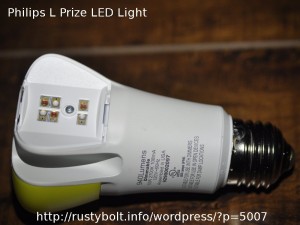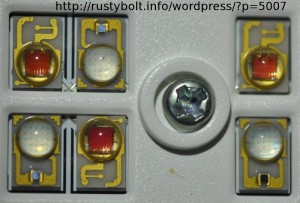CFL light bulbs have their disadvantages (see note below). Now that the LED light bulbs are becoming more available and cheaper, there is an alternative to the CFL problem. Yes, the LED lights are more expensive, but they save he buyer a lot in the long run. I watched this Youtube video by a guy who bought one of the Philips Ambient LED light bulbs. I agree with him 100 percent. I have bought several Philips LED light bulbs and they all work like they are supposed to work, with excellent results.
There has been a large percentage of the white LEDs that do not live up to the claims that they “last for 100 thousand hours”. I have done lifetime tests on the white LEDs I have purchased and I’ve found most of them die an early death. The Federal Trade Commission has taken a maker of LED light bulbs to court for falsely advertising the performance and lifetimes of their LED lights. I have been very concerned about the lifetime of these new LED light bulbs. I have had a Philips 2.5 watt candelabra light running 24/7 for the almost two years and it has lost some of its brightness but is still very bright. This has given me confidence in Philips LED light bulbs so that I will recommend them to anyone who wants to save a lot on their electric bill.

 When the above video finished, I was given a choice to watch this Youtube video of the new Philips “L Prize” LED light bulb. This is the one that I bought for $24.99 at Home Depot a few weeks ago. I do not agree – now that their price has come down – with his claim that the earlier bulbs are a more cost effective purchase. In either case, older or newer, they will save much more than their cost over their lifetime, and therefore are much more than worth the cost. Recently I saw they were selling for $33 on Amazon. If you’re lucky you might be able to find them at the Big Box stores for cheaper.
When the above video finished, I was given a choice to watch this Youtube video of the new Philips “L Prize” LED light bulb. This is the one that I bought for $24.99 at Home Depot a few weeks ago. I do not agree – now that their price has come down – with his claim that the earlier bulbs are a more cost effective purchase. In either case, older or newer, they will save much more than their cost over their lifetime, and therefore are much more than worth the cost. Recently I saw they were selling for $33 on Amazon. If you’re lucky you might be able to find them at the Big Box stores for cheaper.
I really liked his demo of the LEDs inside. I was surprised that there are red LEDs inside. He also used a term that I haven’t heard before: remote phosphor technology. Most white LEDs have the phosphor inside, but this one uses phosphor that it outside of the LED itself. One other point he forgot to mention. The L Prize required that the LED light be made in America. The other Philips lights that I have are made in China, so if you’re an American, do your country a favor and choose them over the foreign made ones.
Update Nov 18 – I went to the big box store again to buy some more Philips L Prize lights. They still had a bunch, but they were still hidden way back in the back of the electrical dept. How do they think they are going to sell them if they are difficult to find? Not only were they still on sale, but they were now marked down to $20, so I bought a bunch more. I gave one to my friend, and hopefully it will work well with his new lighting system. I may go back and buy some more. I’ve included some pictures of the LEDs inside. I got the yellow plastic cover off by prying on the flat end closest to the scew base (it’s thin plastic so one has to be gentle). As the video showed, each of the three ‘lobes’ has three blue LEDs and three red LEDs. I can see the wires in the red LEDs, but I can’t see any wires inside the blue. Weird, huh?. I put the yellow cover over a 5mm blue LED and it changed the blue light into white light, like magic. Really quite a simple solution: put the phosphor outside of the LED.
I put the LED light, minus the yellow cover, into a light socket and turned it on. The light is a very bright purple or violet light, due to the combination of the blue and red LEDs emitting simultaneously. If you want a crazily bright violet light, get one of these and remove one (or more if you dare) of the yellow covers, and turn it on. It’s hard to believe that those very bright red and blue LEDs are magically transformed into white light by some thin pieces of plastic.
I thought that I will probably be told I was nuts for spending a couple hundred dollars on light bulbs. But the savings will start to accrue immediately. The first few months I might save five bucks, so after two years I’ll have saved a hundred dollars. Maybe four years later I’ll have paid for them, and any further savings will be money in my pocket. But the environmental savings will also be immediate. No more incandescents or CFLs to fail.
One person at work told me that their cathedral ceiling was so high they couldn’t change the light bulbs when they burned out. Well , now they can get a tall ladder or someone to replace the lights up there with these LED lights one time, and they won’t have to change them for decades. Really! A few years ago I read some of Don Klipstein’s LED web pages, where he was looking forward to when LEDs were as efficient as CFLs and were not too expensive. Now it looks like that time has finally arrived.
Update Nov 19 – I bought a bunch more, and some socket extenders. I figure that if I put the LED lights into the recessed fixtures, they may get too hot. So if I extend the light out so that it has more air flow, it will stay cooler. And also more light will spread out across the room.
Notes
Note – I have told my co-workers that they should get rid of the old incandescent light bulbs and replace them with CFLs, but they have complained that the CFLs don’t last very long before they burn out. I think the biggest factor in causing them to burn out is they are used with the globe or ‘spiral’ pointing down, so the heat rises and the circuit in the base overheats, shortening its life. Another reason is that they get the very cheap ones from bargain stores, and these are lower quality than the brand name ones. But where I live, Southern Calif. Edison gives a discount rebate to the seller, so the buyer pays a lot less for these. One has to remember that a typical incandescent light lasts only a little over a thousand hours, so even if the CFL burns out, it still saves the buyer a lot of money on his electric bill.
Another important point about LED lights. The technology is new and the prices have not yet come down to near that of CFLs. People are very hesitant to spend what they think is too much money on what they see is “just another light bulb.” But they do not see the potential savings in their future electric bills the LED lights will give. This saving more than compensates for the higher cost – the consumer should not be hesitant to buy the LED lights because the sooner they buy them, the sooner they will start saving.
The consumers don’t want to spend a lot on a light bulb (or should I say, don’t want to spend a lot more than they have been spending on a light bulb). The LED light makers know this so they make sacrifices in quality and construction to make the lights cheaper, and the consumer gets an inferior product at the cost he desires. But then there may be sacrifices in the lifetime and quality of the light from the LED light. I saw this same thing happening when the white LEDs first came out: they had a bluish ring in the light pattern – something we don’t see today. I had numerous experiences with LEDs that were low quality and/or short lifetimes. I have not seen this low quality with Philips products that use LEDs. As a consumer these LED lights meet or exceed my expectations for quality and lifetime.